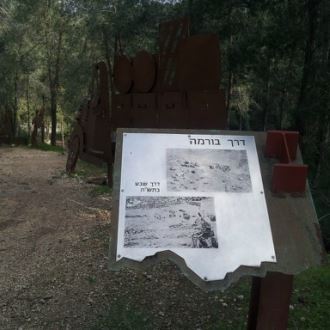The Boxthorn Trail and the Rampart Trail
A circular route along the Canaanite embankment and the beach
A beautiful beach, an ancient rampart and a peninsular jutting out into the sea - all waiting for you at the Palmahim Beach National Park. The Israel Nature and Parks Authority has marked out the Boxthorn Trail and the Rampart Trail at the site, and these will lead you to the steep Yavne Yam cliff and the beautiful spots which adorn the Palmahim Beach.
Main points of interest:
Beach for bathing
The Yavne Yam site
Typical coastal flora and fauna
A great rampart from the Caananite city
Turtle farm
Viewpoint
The Yavne Yam cliff viewpoint overlooking the National Park
Lookout from the top of the Canaanite rampart
Israel Nature and Parks Authority activities to improve visitor services and preserve the site
The Authority has set up the beach for bathing, marked out walking trails, and is carrying out archaeological excavations in the National Park. As for nature conservation, it rescues sea turtle eggs, and when these hatch they are released safely into the sea.
How to get here:
From the Tel Aviv-Ashdod road (Route 4), at the Gan Raveh interchange turn onto Route 4311 to Palmahim. On the way to the National Park you will pass over Nahal Sorek and the Paratroopers Grove. Go past the entrance to Kibbutz Palmahim and you will reach the parking area.
Background
The Palmahim Beach National Park is a well-known holiday and leisure site for beach-lovers, but it is also a Nature Reserve which preserves the natural beach, the Kurkar Ridge and shifting sands beaches. The National Park also includes Tel Yavne Yam.
White broom bushes are very widespread across the sandy areas, which blossom in February with abundant white blooms. Another common bush is the Artemisia monosperma. These two plants are also typical of desert sands. Near to the coast, the wind brings with it a salty spray from the sea, and the plants here have developed a resistance to this: beach morning glory tends to grow lying down; sea cudweed develops a thick covering of hairs, and sea daffodil leaves are covered with a thick layer of wax. Coastal plants mainly blossom over summer nights, since this is when the wind is gentle and does not disturb their insect pollinators.
Within the National Park is a rich world of wildlife, including large mammals such as the oryx, jackal, red fox and wild boar. These animals also enjoy the sands and the farming fields beyond the National Park. The fauna here includes animals unique to sandy habitats such as the crowned leafnose snake, the acanthodactylus scutellatus and the wedge-snouted skink.
Trip route
1. The Boxthorn Trail
Start from the south-east corner of the parking area (go past the cash desk and turn south). The trail goes past the Kurkar Ridge, covered with dense greenery. The spiny boxthorn plant stands out in particular, as well as white broom and the climbing plant Prasium. This is the Boxthorn Trail. It is around 600 m in length and it ends at the rising cliff of Yavne Yam.
2. Yavne Yam
Yavne Yam is a large rock cliff which juts out into the sea at the southern edge of the National Park. It is the most prominent remnant of the ancient port city. The site was settled for the first time in the Middle Canaanite period II (1200-1550 BC). In this period, the settlement was surrounded by a great rampart, surrounding an area of 600 dunams in an arc shape. The northern edge of the arc reaches Palmahim beach, and the southern end is the Palmahim Base, south of the access road to the beach. Even though it was built 3,500 years ago, the rampart has an impact on the local landscape to this day.
From then until the Middle Ages, there was a port at Yavne Yam, an important docking location. The city flourished during the Late Bronze Age (1550-1200 BC), when Israel was under Egyptian rule, as well as during the Persian period (539-- 332 BC), and maritime trade developed highly here.
During the Hellenistic period (332-63 BC) both gentiles and Jews lived in Yavne Yam. II Maccabees tells us that Judah the Maccabee (in 163 BC) burnt the port and the city’s ships, in order to prevent a plot by the gentiles to drown their Jewish neighbours in their ships.
The settlement flourished once more in the Byzantine period (324-638 AD). The city was nicknamed ‘Mahoza di Yamnin’ - the port of Yavne - and was a very important port city. Many pilgrims disembarked form their ships here. In excavations under the leadership of Prof. Moshe Fisher from Tel Aviv University, remains of magnificent public buildings from this period were uncovered, including impressive mosaic floors.
Yavne Yam also flourished Early Arab Period, during the rule of the Umayyad Dynasty (661-750 AD). At that time the city was called Maahoz Yavne - Yavne Port. Under Caliphate rule up until the Abbasid Caliphate (750-1250) the site became a military outpost, and during the Mamluk Period (1260-1516) it was known as Minat Rubin - Rubin Port - named after the Nabi Rubin Mosque next to Nahal Sorek.
3. Beach
From Yavne Yam the trail continues north over the cliff, parallel to the sea. This is the Cliff Trail, which leads to service centre of the National Park and the lifeguard’s hut. Many species of plants grow on the ridge, in particular sea fennel - a fleshy plant whose flowers look like a yellow umbel, and the oenothera - a plant with large yellow flowers.
On this part of the beach you can see beach rocks and eolianite rocks. The waves crash against these, flow over them and then flow back. This is a picturesque natural world, where the rocks are a habitat for a rich world of oysters, crabs and many other animal species, with plovers and sandpipers wandering among them.
You can stop here, but we would recommend continuing to stroll along the beach. At the point where the beach becomes very narrow there is a signpost pointing right to the Rampart Trail, which is the northern part of the ancient rampart.
4. Turtle farm
On the beach, next to the rampart, a sign points to a small defined area: The Turtle Farm. Female loggerhead sea turtles and green sea turtles come up onto the beach on summer nights, dig nests, and bury their eggs in them. They then cover the nests and return to the sea. The eggs buried in the sand are left unattended, and vehicles, bathers and animals present a danger to them. Sea turtles are rare creatures in Israel. In order to preserve the population, inspectors from the Israel Nature and Parks Authority patrol the beaches in Israel. Nests found in the Palmahim area are moved to the farm in the Palmahim Beach National Park, and there the eggs are completely protected. In the summer of 2014 the eggs from ten nests on the farm hatched, and the baby turtles made their way safely into the sea.
5. The Rampart Trail
Climb up the rampart. At the top of the there is a spectacular lookout point. To the east you can see the hills of the Shfela region and the Judean Hills rising above them. In front of these you can see the Yavne industrial zone, Ness Ziona, Rehovot and Rishon LeZion. You can also make out the Azrieli Towers and Midgal Shalom in Tel Aviv. Near here, after the end of the rampart, you can see the houses of Kibbutz Palmahim, and to the south the cooling towers of the Ashdod power station.
From the rampart you can go straight down to the parking area, and this is the end of the walking trail.
photos : Pikiwiki Web
- Type
- Hiking
- Region
- Tel Aviv & Center
- Near to
- Rishon Le Zion
- Length
- 2 Km
- Duration
- About 1 Hour
- Recommended season
- Spring, Summer, Autumn
- Starting point
- Palmahim Beach National Park (map)
- Ending point
- At the starting point (map)
- Precautions
- Do not approach the edge of the cliff at Tel Yavne Yam
- Parking
- Parking
- Circular
- Circular
- Drinkable water
- Drinkable water
- Bathing water
- Bathing water
- Suitable for children
- Suitable for children
- Picnic suitable
- Picnic suitable
- Phone
- +972-3-7265633
- Fax
- +972-3-7263902
- gl-palmachim@npa.org.il
Similar trails







Nearby attractions







Nearby restaurants







